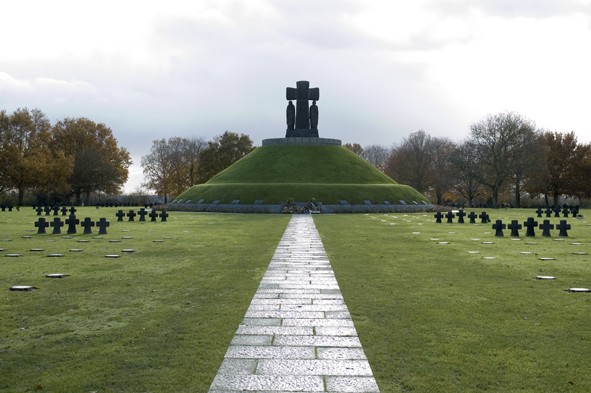An exhibition in the information centre uses examples to document what people suffered through during the war. It describes their fates and lets people have their say. The images and stories of death, suffering, destruction and war graves are juxtaposed with hopeful examples of reconciliation, understanding and friendship.
Today, 21,245 German soldiers have found their resting place in La Cambe. 207 unknown dead and 89 who are known by name are laid to rest in the burial mound.
In the summer of 1944, more than 100,000 people died during the fighting that followed the Allied landings in Normandy. At least 14,000 French civilians lost their lives. Even as the fighting in Normandy continued, the American Recovery and Identification Service already laid out two large cemeteries with both their own and German fallen, near the small village of La Cambe. After 1945, the American forces transferred their dead to the cemetery of St. Laurent-sur-Mer, 15 kilometres away. The bodies of the German soldiers were exhumed there and buried in La Cambe.
In 1954, at the beginning of the Volksbund Deutsche Kriegsgräberfürsorge's (German War Graves Commission) reburial work, La Cambe cemetery was already one of the largest provisional German military cemeteries of the Second World War in France, with about 8,000 dead. Subsequently, the remains of 12,000 German soldiers from 1,400 graves, as well as another 700 bodies found at scattered war sites in Normandy, were interred at La Cambe. On 21 September 1961, the La Cambe War Cemetery was officially inaugurated.
In 1957, an international youth camp took place under the motto "Reconciliation over the Graves". This was the first time that young people from several nations helped the Volksbund establish a war grave site in France. Next to the cemetery is Peace Park, opened in 1996. Here, 1,200 spherical maple trees grow as living symbols of peace and reconciliation. La Cambe was the Volksbund's first peace park. In the following years, three more were built in Budaörs (Hungary) and Sologubovka (Russia).
Accessibility information:
The barrier-free access to the cemetery was completed in 2012. A direct connection to the bus car park makes it possible to reach the war grave site by a short route and without much effort. In July 2016, the Volksbund Deutsche Kriegsgräberfürsorge installed a stainless steel railing so that older visitors can also safely climb to the burial mound.
Les Noires Terres, 14230 La Cambe, France
+33 (0)2 31 22 70 76
